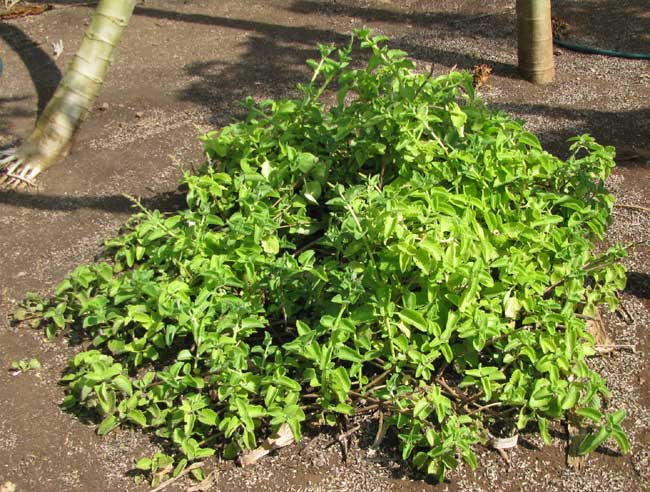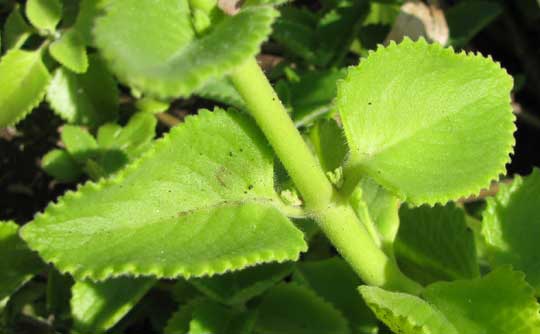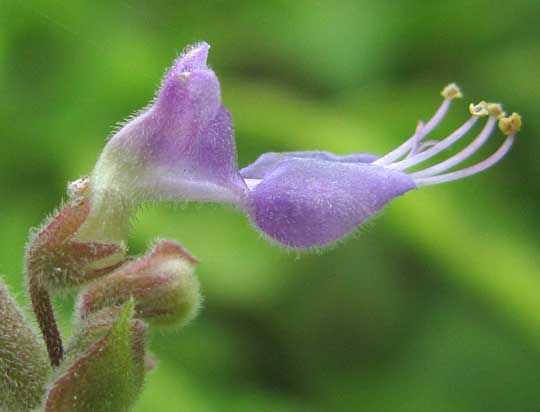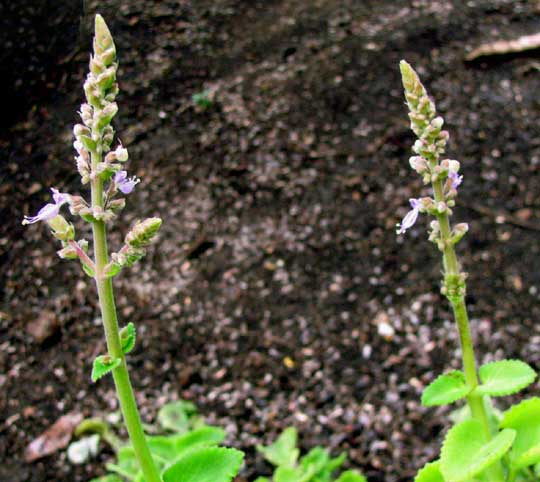Excerpts from Jim Conrad's
Naturalist Newsletter

from the January 30, 2011 Newsletter issued from Hacienda Chichen Resort beside Chichén Itzá Ruins, central Yucatán, MÉXICO; limestone bedrock, elevation ~39m (~128ft), ~N20.676°, ~W88.569°
CUBAN OREGANO
Back in October we looked at Mexican Oregano, reviewed at www.backyardnature.net/yucatan/oregano.htm. Right beside our Mexican Oregano there's what's shown above.
That's Cuban Oregano and unlike Mexican Oregano, which is a much-branched shrub up to six-ft-high (1.8m), Mexican Oregano is a scrambling perennial with stems too soft to call woody and too hard to call herbaceous. Its semi-succulent, crisp leaves are shown below:

Northerners are familiar with a delicate little herbaceous mint known as Oregano, Origanum vulgare, originally from Europe. Mexican Oregano, native to Mexico, instead of belonging to the Mint Family, was a Lippia, in the Verbena Family. The present Cuban Oregano is a member of the Mint Family like "real Oregano," but belongs to a completely different genus. It's PLECTRANTHUS AMBOINICUS, originally from southern and eastern Africa.
I can't tell the difference between tastes of the leaves of "regular Oregano," Mexican and Cuban Oregano. In the Hacienda's famous kitchen, both the latter are used whenever the Oregano taste is called for, and the culinary results are splendid.
English names for the various oreganos are very confusing and misleading. Among Mexican Oregano's other English names were Scented Lippia, Scented Matgrass and Redbrush Lippia. Our present Cuban Oregano seems to have even more names, including Spanish Thyme, Indian Borage, Mexican Mint, French Thyme, Soup Mint, Indian Mint and Country Borage. One reason for the proliferation of names is that Cuban Oregano is very widely cultivated and naturalized in the Old and New World Tropics, so many cultures have come up with many names.
In fact, if you use the Google Image search feature on the keywords PLECTRANTHUS AMBOINICUS you'll see cultivar forms with variegated and/or frilly leaf margins, and blossoms in various purple-tending shades. Our flower's hue is a little different from most, so maybe this is a cultivar the Maya have been working on, through selective breeding, for the 500 years since the Spanish Conquest.
Cuban Oregano's flowers are classic mint flowers, seen below:

By "classic mint" is meant that the flowers are bilaterally symmetrical instead of radially, with four or two stamens, and that the ovary and is composed of four distinctly separated parts.
The plant's inflorescence is shown below:
